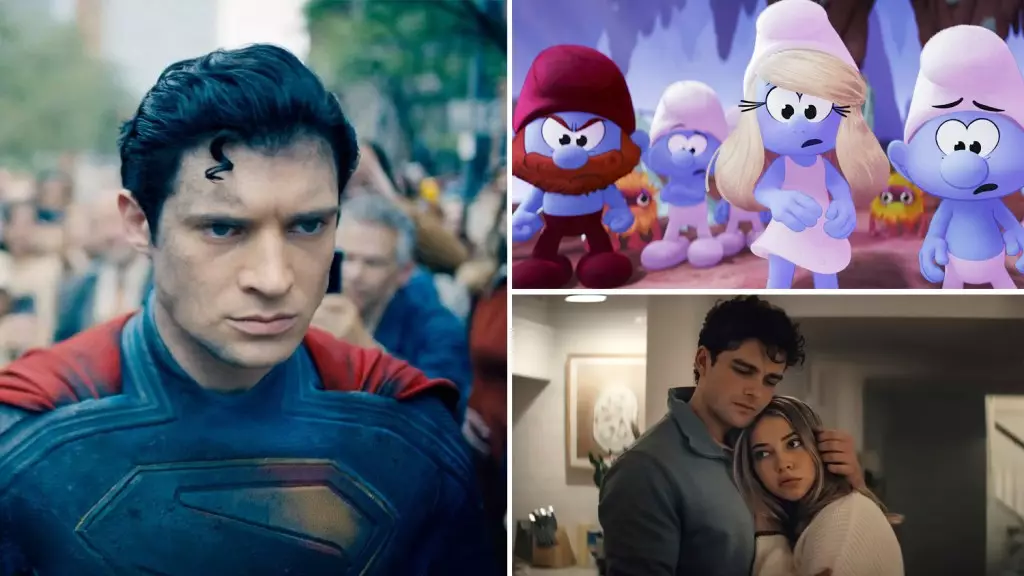The current box office landscape reveals a sobering reality: even major franchise films are struggling to sustain their appeal. Warner Bros/DC’s Superman’s second-weekend earning of roughly $16 million, down 71% from its opening, exemplifies how blockbuster fatigue is settling in. While a $55M-$60M second weekend might sound decent in a vacuum, it’s a stark reminder that audiences are becoming increasingly selective, or perhaps disillusioned, with big-screen offerings that once drew crowds in throngs. The fact that these superhero films – once the crown jewels of Hollywood – are showing such rapid declines signals an erosion of audience loyalty. This isn’t an isolated incident; the trajectory suggests a deeper malaise within both the industry’s blockbuster model and consumer appetite.
The numbers hint at a fundamental shift in audience behavior, where spectacle alone no longer guarantees sustained engagement. The enthusiasm that once fueled billion-dollar openings is waning, replaced by skepticism and a thirst for more meaningful content. As legacy franchises struggle to keep viewers interested, it becomes evident that Hollywood’s reliance on predictable formulas and remakes is increasingly risky. Studios are aware of this, which is why some are trying to diversify, but the core problem remains: audiences are demanding more authenticity and entertainment value, not just CGI overloads.
Sequels and Reboots: A Tired Cycle of Reinventing the Past
Revisiting familiar properties like *I Know What You Did Last Summer* and *The Smurfs* demonstrates Hollywood’s desperate attempts to cling to past successes. Both films are positioned as potential hits, yet they exemplify the industry’s reluctance to innovate. *I Know What You Did Last Summer’s* modest pre-release numbers suggest that nostalgia alone isn’t enough to guarantee a hit, especially when critics give it a tepid 38% on Rotten Tomatoes contrasted with a surprisingly strong audience score of 69%. That disparity underscores a crucial point: today’s viewers often crave stories that resonate emotionally, rather than simply offering familiar faces and brand names.
Meanwhile, the *Smurfs*’ performance underscores the shifting demographic appeal – younger audiences may be loyal to these characters, but in a competitive market flooded with options, their loyalty can’t sustain blockbusters. The international merchandise machine remains a lucrative component, but reliance on ancillary revenue speaks to a weakened core theatrical performance. The fact that these properties are primarily aimed at children further alienates adult viewers, intensifying their struggle to appeal broadly. This obsession with franchising and merchandise underscores a broader industry trend: Hollywood operates more as a licensing business than as a creator of original narratives.
The Diminishing Returns of Franchise Itself
The financial trajectory of recent superhero and franchise films shows diminishing returns, with even prominent titles such as *Gunn’s Guardians of the Galaxy Vol. 3* and *Reeves’ The Batman* declining notably after their first weekends. Their second-weekend drops demonstrate how fragile the initial hype can be. The industry’s penchant for chasing these lucrative but increasingly predictable properties might yield short-term gains, but it also risks eroding the trust of a discerning audience.
Particularly telling is the performance of *Superman*, which despite a sizable $232.7 million domestic haul by Sunday, faces a future of diminishing relevance unless fresh storytelling revitalizes its appeal. Warner Bros’ reliance on familiar IP, rather than investing in compelling new characters, could be a recipe for continued stagnation. Without innovation, these films risk becoming cultural relics, viewed more as merchandise generators than meaningful art or entertainment.
The Reality Check of Critical Reception vs. Audience Engagement
Critical reception of these films often indicates the impending decline in quality or originality. *I Know What You Did Last Summer* and *Eddington* have middling critic scores, yet audience reactions tell a different story. The latter’s 66% fresh rating suggests that viewers can sometimes find entertainment value even if critics dismiss such films. However, this disconnect diminishes over time when box office performance diminishes or when newer, more innovative content manages to captivate audiences who are increasingly skeptical of recycled narratives.
The decline in cinematic originality reflects a broader cultural shift: audiences are tired of formulaic studios recycling the same tropes ad nauseam. Studios, in turn, have become risk-averse, preferring safe bets over genuine innovation. This cycle of safe sequels, reboots, and franchise expansion might pad short-term box office numbers but ultimately undermines the industry’s creative credibility.
The Future of Hollywood: Will Risk and Innovation Resurface?
As the industry grapples with these dismal numbers, one thing remains clear: a reckoning is overdue. Hollywood has become increasingly reliant on nostalgia, merchandising, and franchise fatigue rather than crafting compelling, original stories. This approach risks turning cinemas into graveyards of failed ambitions, where only the most bankable properties get a pass.
Without a strategic shift—embracing fresh storytelling, daring risks, and authentic experiences—the industry will likely continue its downward spiral. Audiences are signaling their desire for more than just superficial spectacle; they crave narratives that challenge, resonate, and offer a sense of genuine novelty. Whether studios heed this call remains to be seen, but one thing is certain: if Hollywood continues down this path of complacency, the golden age of blockbuster cinema will be nothing more than a distant memory.

